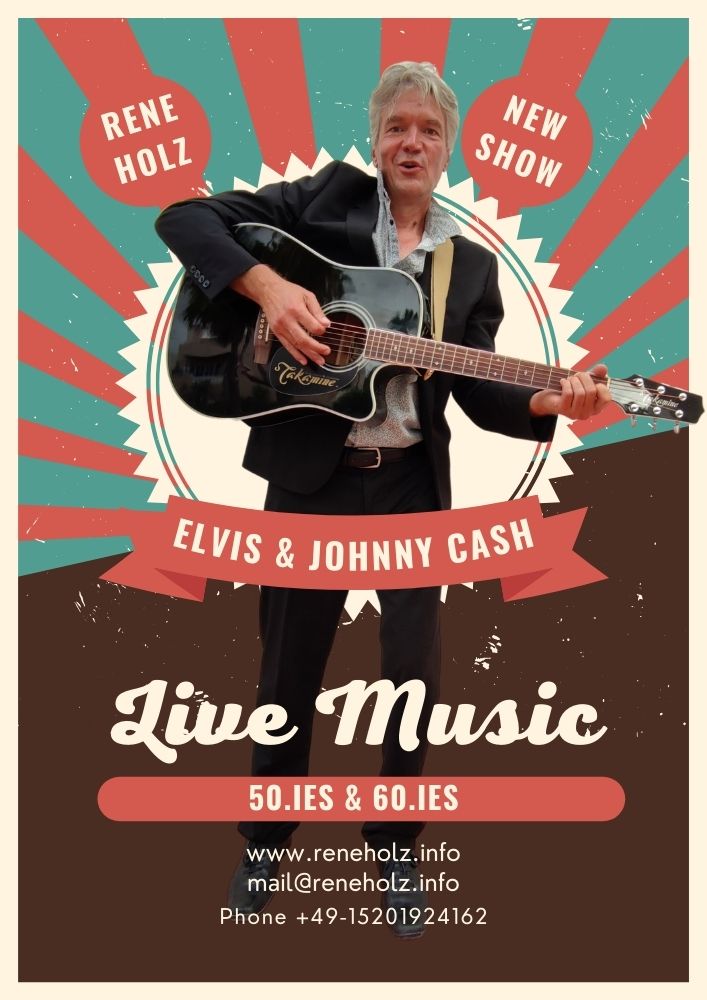The Sound Of Elvis & Johnny Cash - 50ies & 60ies - Live Music Golf del Sur, San Blas, El Médano

In the late 1950s, two young men, each poised on the brink of music superstardom, shared stages, stories, and pivotal moments in their burgeoning careers. Their names? Elvis Presley and Johnny Cash. Today we take a journey back in time to the inception of their careers, the music that propelled them to stardom, and the moments they shared together on stage.
The roots of their stories can be traced back to Sun Records in Memphis, Tennessee. Sam Phillips, the owner of Sun Records, was instrumental in launching the careers of both Elvis and Cash. His knack for recognizing talent and his dedication to cultivating unique soundscapes allowed artists under his wing to shine.
Elvis Presley, the King of Rock ’n‘ Roll, first walked into Sun Records in 1953, hoping to record a song as a birthday present for his mother. Phillips, however, saw a spark in Elvis that transcended the amateur performance he’d initially displayed. Under Phillips’s guidance, Elvis released his first single, „That’s All Right,“ in 1954, which quickly gained local popularity and marked the beginning of a remarkable journey.
Meanwhile, Johnny Cash, the Man in Black, had been trying to make it in the music industry. With a deep, resonating voice and a style blending country, gospel, and blues, he brought something fresh to the table. He signed with Sun Records in 1955 and released „Cry! Cry! Cry!“ The single’s success on the country charts marked the beginning of Cash’s steady rise in the industry.
One of the most pivotal moments of their early careers came on December 4, 1956. Known as the „Million Dollar Quartet,“ this impromptu jam session at Sun Records included Elvis Presley, Johnny Cash, Jerry Lee Lewis, and Carl Perkins. While no „on stage“ performance took place, the energy and camaraderie of this session remain emblematic of the shared experiences and mutual respect between these legendary musicians.
During these formative years, Elvis and Cash were often on the road together, participating in package tours where several Sun Records artists would perform. They shared stages, long bus rides, hotel rooms, and countless meals. The bond between the two deepened during this period. It’s said that Elvis often performed Cash’s „I Walk the Line“ in his concerts, and Johnny would joke about his attempts to mimic Elvis’s hip-shaking dance moves.
The unique sounds and styles that Elvis and Cash introduced were a breath of fresh air in the music industry. Elvis’s energized performances and fusion of blues, country, and gospel, alongside his unprecedentedly provocative stage presence, quickly won the hearts of fans across America. His charisma, talent, and flamboyant style resulted in the rise of a new musical genre, Rock ’n‘ Roll.
In contrast, with his all-black attire and solemn demeanor, Johnny Cash presented a stark contrast to Elvis’s flashy presence. His music, imbued with themes of sorrow, moral tribulation, and redemption, resonated with a wide audience. Cash’s authenticity and storytelling prowess led him to be one of the most influential musicians in the country and rock genres.
Despite their differences, both artists managed to captivate audiences and redefine musical boundaries, paving the way for future generations of musicians. As contemporaries and friends, the early shared experiences of Elvis Presley and Johnny Cash significantly shaped their careers. Their legacy, a testament to their extraordinary talent and the power of their music, lives on, continuing to inspire and influence artists worldwide.
From Sun Records‘ humble studio to the biggest stages worldwide, the early careers of Elvis and Cash were marked by their groundbreaking music, charismatic performances, and a deep-rooted friendship that transcended their differing styles. They were two different men with two different sounds, yet their shared history and mutual respect for each other’s talent remains an intriguing chapter in the annals of music history.